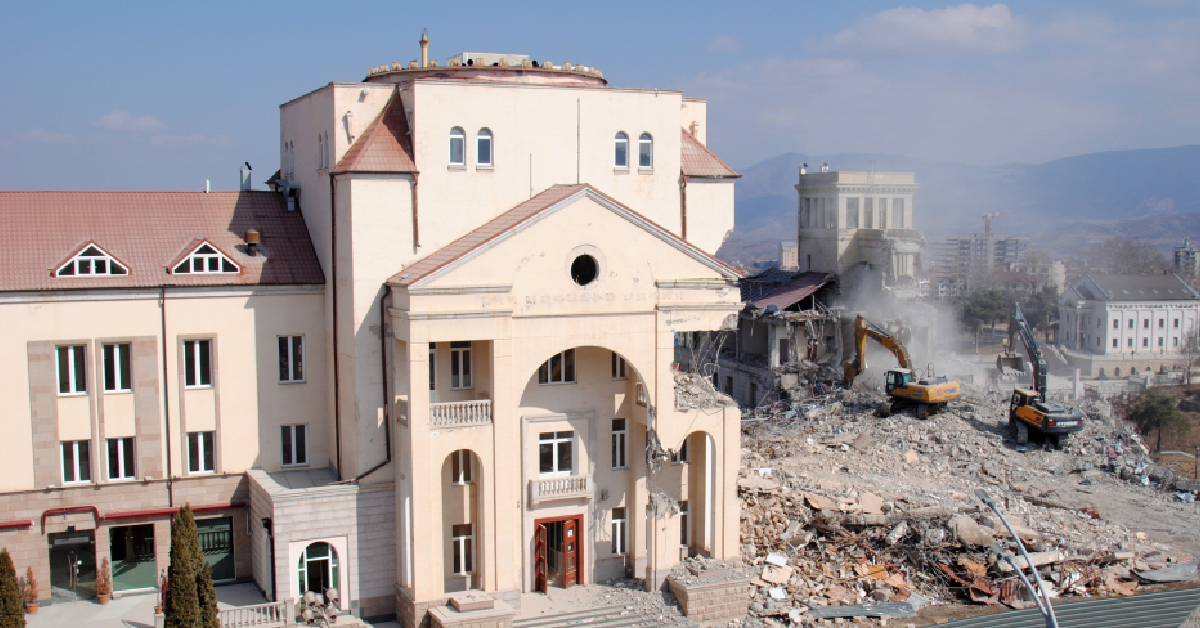2025
2025
2025-10-03

In the photo: Azerbaijan is demolishing the National Assembly building of Artsakh
Azerbaijan’s deliberate and systematic destruction of Armenian cultural heritage in Nakhijevan, Artsakh, and other areas has been well documented with numerous indisputable facts. This policy has been widely examined and discussed across various platforms.
Laurie Georges, a researcher at the Department of Political Science at Ohio State University, has examined this policy from a new perspective, noting that since the early years of the Soviet Union one of its main objectives within the framework of nation-building was to foster a sense of attachment among Azerbaijanis toward Nagorno-Karabakh. The article was published in the prestigious academic journal Nationalities Papers under the title “Knowledges that Cannot Be Known: Structuring Azerbaijani Attachment to Nagorno-Karabakh.”
The article shows how mechanisms of erasure and forgetting were used to structure a sense of attachment to the territory among Azerbaijanis.
In scholarly literature, this phenomenon is defined as “structural ignorance.” This type of ignorance is not a mere lack of knowledge on a given issue, but rather the deliberate production of ignorance or the promotion of a dominant view through faulty accounts.
The authors mentions that the state structures ignorance among the core group about the symbolic significance of the state territory and about the oppression/erasure of non-core groups inhabiting it. This structured ignorance produces particularly rigid attachments.
Structured ignorance shapes perceptions. Georges argues that Azerbaijanis learn to mis-see ethnic Armenians as “barbaric,” “uncivilized,” “opportunistic,” and not vulnerable (which makes them incapable of reason and ineligible to justice claims). They learn to conceive NK as Azerbaijan’s cradle of civilization, and to misinterpret the acts of ethnic Armenians as malignant. Azerbaijanis learn to misremember events and violence against ethnic Armenians; accounts of anti-Armenian pogroms become conspiracy theories.
The appropriation of territory is carried out in various ways. The physical or material practice refers, for example, to infrastructural changes. It is noted that during the Soviet period, major highways bypassed Nagorno-Karabakh. More radical examples include the physical removal of people and the destruction of buildings and the natural environment.
More specifically, the ruins of Armenian towns and quarters from previous episodes of violence (such as the massacres of Khaibalikend and of Shusha in 1919–1920) were destroyed, while damaged churches and khatchkars were left in disrepair. “The narrative that Shushi is an Azerbaijani historical place partly relies on the erasure of Armenian traces following the 1920 massacre, which killed and displaced the entirety of the Armenian inhabitants and destroyed the Armenian part of the city.” Another example is the creation of unfavorable living conditions that forced Armenians to leave their homes.
Among the ideological practices is the publication of maps, catalogues, and books in which Nagorno-Karabakh’s Christian monuments were deliberately omitted. The next example is the rewriting of history. During the Soviet period, historians were tasked to write the Azerbaijani history that was disseminated through school textbooks. According to the author, these textbooks created an artificial connection between Azerbaijanis and Caucasian Albania, omitted the Armenian origins of the Albanian alphabet, “Azerbaijanized” historically significant figures, and promoted the idea that Armenians had never lived in Nagorno-Karabakh.
Since 1988, structural ignorance has expanded on a much larger scale. The construction of ignorance is carried out through the erasure of memory. The author cites two examples: the forgetting of the Sumgait and Baku pogroms and the destruction of Armenian cultural heritage in Nakhijevan. This approach continues today in Nagorno-Karabakh, where Azerbaijan is destroying Armenian historical cemeteries, churches, and other structures.
Thus, such studies demonstrate that Artsakh holds a cornerstone role in Azerbaijan’s nation-building and indigenousness propaganda in the region. We have previously presented another extreme example of Azerbaijani nation-building: how prehistoric humans who lived millennia ago are portrayed as Azerbaijanis, while archaeological remains preserved in Gobustan, near the village of Azokh in Artsakh, and other sites are presented as evidence of Azerbaijani indigeneity.
The author of that study, Uri Rosenberg, described it as “overkill and exagerrated effort.” Laurie Georges considers the Azerbaijani case “on the extreme end of the spectrum.” The fact remains that for decades, Azerbaijan’s leadership has fueled Azerbaijani nation-building and nationalism through extreme contradiction, hostility, and rejection of Armenians and Armenia. A vivid testament to this is the policy of completely erasing the Armenian presence in Artsakh, documented in numerous photographs and videos.